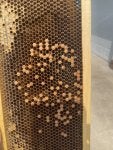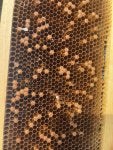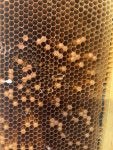Replaced bottom board with screen bottom board 5 days ago. Six seams bees in top box.. two. medium boxes, June swarm. Had a couple of brood frames mostly hatched out,6 full honey frames. 5 Oav treatment in aug. one day mite drop less than 10. Last year all 8 hives survived.
yesterday I noticed hives on both sides had almost bearding and were doing heavy grooming. Didn’t think much of it till today I noticed no acitive in center hive, opened it to find two seams total, no hive beetles no signs of mites. Larva some yellow, some capped brood alive some capped brood milky, not stingy.
any idea what I have going on? attached what brood looked like. Big queen was still in hive.
yesterday I noticed hives on both sides had almost bearding and were doing heavy grooming. Didn’t think much of it till today I noticed no acitive in center hive, opened it to find two seams total, no hive beetles no signs of mites. Larva some yellow, some capped brood alive some capped brood milky, not stingy.
any idea what I have going on? attached what brood looked like. Big queen was still in hive.







